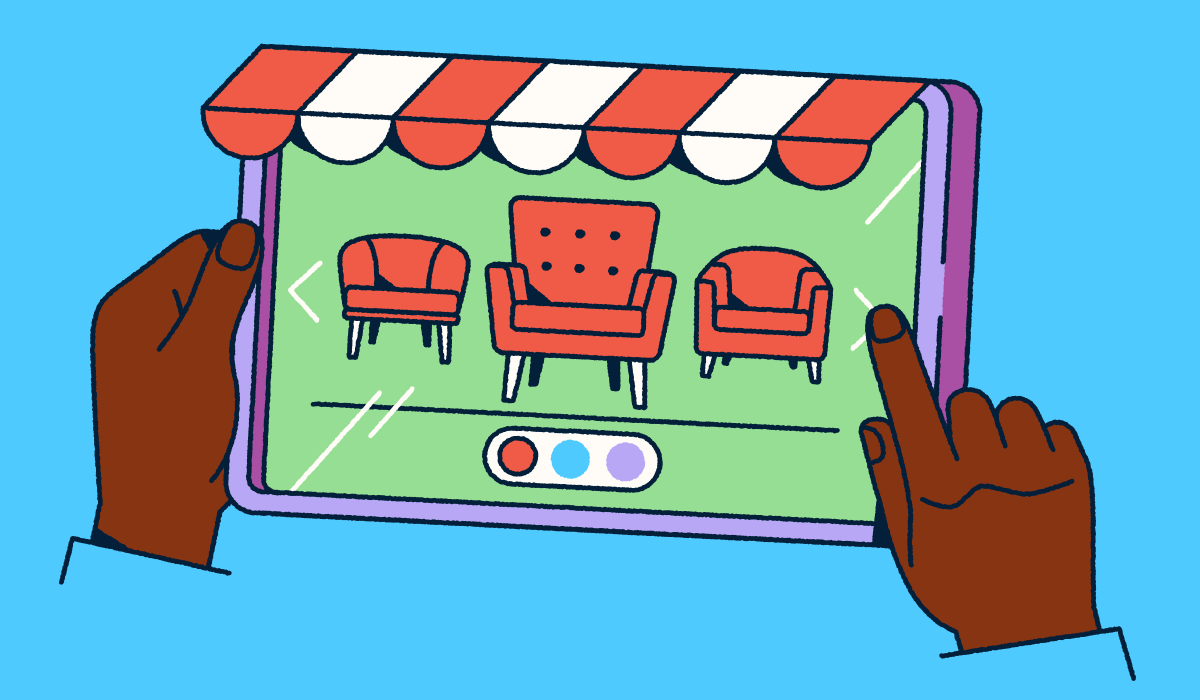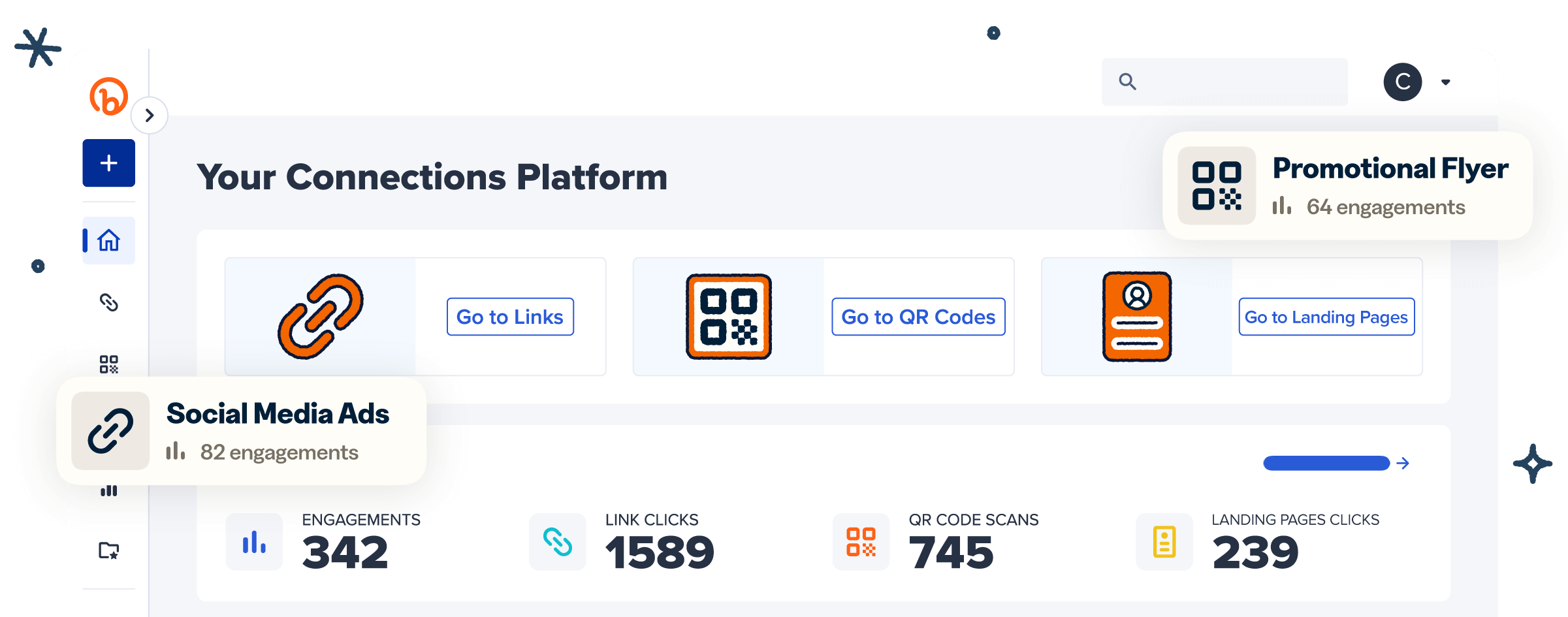Understanding how customers move between your physical and digital touchpoints is critical for improving retail experiences. Today’s brands can no longer afford to treat in-store and online engagement separately—every scan, click, and action provides valuable clues about what’s working and what needs adjustment.
Digital experience insights can help retail teams see the full picture. These metrics show how customers interact with signage, stores, mobile content, and campaigns across their journey. With the right tools, brands can connect offline actions to digital data and make smarter operational decisions.
Bitly helps retailers close that loop with short links, QR Codes, and mobile landing pages, giving retail teams the visibility they need to optimize every step of the customer experience.
Note: The brands and examples discussed below were found during our online research for this article.
What are retail digital experience insights?
Retail digital experience insights come from the behavioral data you collect as customers interact with your digital content. This includes metrics like click volume, QR Code scan volume, engagement trends, and mobile interactions with signage, links, and packaging.
For hybrid retail brands, these insights come from actions taken in-store and online. Customers might scan QR Codes on in-store signage to access product details, join a loyalty program, or unlock exclusive offers. But they might also click on short links in a social media post or email to reach the same resources.
Short links and QR Codes act as connection points in the hybrid retail journey. They serve as digital breadcrumbs that help retailers track customer behavior before, during, and after store visits, giving you a more complete view of the customer experience.
Why they matter in a hybrid retail environment
Today’s consumers move fluidly between digital and physical experiences. They might browse an item on your website before visiting your store in person to purchase it, or discover a product in-store and later buy it online.
In fact, 23% of adults prefer to research products online before buying them in-store, and 67% of social media users are likely to research a product on their favorite platforms before making a purchase.
“Retailers are, more often than not, interacting with their consumers in a digital environment first,” says Luke Reynebeau, Vice President of Customer and Retention Marketing at Bitly. “An in-store experience has become more of a luxury.”
Because of this shift, it’s critical for retail brands to track engagement holistically across all touchpoints. Without full visibility, it’s easy to miss opportunities to refine messaging, optimize offers, or time promotions for greater impact.
What types of data count as experience insights
In retail marketing, there are a variety of key data points that can provide insight into the customer experience, depending on the tools you’re using. For example, with certain Bitly plans, you can track scan and click volume over time and by location (city/country), device type (iOS and Android), and referral source.
These metrics can help retail brands better understand which marketing strategies are most effective and where to invest. That might mean improving in-store signage, refining digital content, or adopting new technology to support customer engagement.
Bitly also enables retailers to compare short link and QR Code performance across different stores, marketing channels, or time periods. “You can look at all your touchpoints to see, across short links and QR Codes, which is driving the most traffic to your loyalty program sign-up,” says Reynebeau.
Who benefits from digital experience data
Digital experience data assists retail marketing, operations, and sales teams by offering a clearer view of customer behavior. These insights help them identify which messaging resonates, when customers are most engaged, and which offers drive conversions.
Store managers, CX leads, and digital marketers can all use experience data to refine promotions, optimize store layouts, time campaigns more effectively, and improve overall performance across locations.
Common ways retailers gather these insights
Marketers can integrate technology throughout the in-store shopping journey to capture valuable digital experience insights.
For example, Bitly Codes make it easy to turn analog touchpoints like product displays or signage into gateways to mobile landing pages, product pages, or loyalty program sign-ups. Meanwhile, Bitly Links help retailers seamlessly direct online customers from SMS messages or social media posts to promos, exclusive offers, and feedback pages.
Together, QR Codes and short links offer a flexible, cost-effective way to gather engagement data without investing in complex or expensive technology.
“Short links are the story when it comes to building a longer tail before people come into your physical storefront,” says Reynebeau. “QR Codes are the bridge from physical to digital.”
Ways to apply digital experience insights in retail
Retail marketing teams can use digital insights to drive real improvements across stores and marketing channels. With Bitly, each use case is measurable and actionable, making it easier to strengthen your digital marketing strategy.
Adjust signage or layout based on scan activity
Retailers can place unique QR Codes on different in-store signage that link to promos, product specs, loyalty program sign-ups, and more. By monitoring QR Code scan volume, your team can identify which signage locations and messaging generate the most engagement.
These insights help you refine your in-store marketing to better connect with shoppers. For example, you might reposition displays or update checkout promotions to align more closely with customer preferences.
For retail brands with multiple locations, it’s also helpful to track which store locations have the highest scan rates. Applying those insights, along with retail marketing best practices, across locations may lift engagement everywhere. If your top-performing stores place exclusive offers near the checkout counter, replicating that strategy across all stores could boost engagement.
Refine offers and promotions by audience behavior
Engagement data can also help retail marketers tailor offers and campaigns based on real customer interest and A/B testing results. Bitly Analytics makes it easy to test which messaging, formats, and channels resonate most with your audience.
Say you want to test which calls to action are most effective on your in-store signage. Just create two different versions, each with a unique CTA and QR Code, and track scan volume to see which one drives more engagement.
“You can compare how a QR Code performs on a postcard versus a short link in an SMS campaign,” says Reynebeau. “That’s a great way to compare cross-channel performance.”
Improve customer experience during peak hours
Making the most of your store’s busiest days is critical, but without the right support, you could lose valuable foot traffic. Research shows that three out of five shoppers will abandon a line before it’s their turn, and over 42% say that waiting in line impacts brand satisfaction, highlighting the importance of adequate staffing and fast service.
Bitly data shows which days your QR Codes receive the most engagement, helping you refine the timing of promotions, adjust processes for rush periods, and ensure staffing matches peak demand.
Enhance customer journey visibility across touchpoints
There are many ways to use QR Codes in retail to turn one-time customers into brand loyalists. To start, you can place in-store QR Codes on signage, packaging, or displays to direct customers to helpful resources like product guides and eco-friendliness details.
While many retailers track in-store activity and digital engagement separately, they don’t always monitor how the two connect. QR Codes bridge that gap, linking physical customer experiences to digital return on investment (ROI) for clearer insights into customer preferences.
Create better follow-up and retargeting strategies
The digital experience insights you gather from Bitly can also strengthen your follow-up and retargeting strategies. When paired with other marketing tools like CRMs or ad platforms, these insights can help you deliver more personalized offers that resonate with customers and drive repeat business.
With Bitly, you can see how, where, and when customers are interacting with your QR Codes and short links. But when you pair them with UTM parameters, you can also use tools like Google Analytics to see which actions lead to opt-ins, purchases, or other conversions. From there, you can trigger retargeting workflows or follow-up messages that guide customers further down the sales funnel.
How Bitly helps retailers track and optimize digital experiences
Bitly serves as your hub for tracking digital experience insights. “With Bitly, all your connection points—short links, QR Codes—are easily created and shared across the entire customer journey,” says Reynebeau. “You can track them all in one place.”
Bitly also lets you create short links and QR Codes that align with your brand for consistency and professionalism. You can customize your Bitly Codes with your brand’s colors and logo, then use your own domain and personalized back-halves for your short links.
For inspiration, check out our gallery of retail QR Code ideas to see how other brands are using these tools to enhance the shopping experience. Once you’ve created your assets, you can tag and organize them by campaign to keep everything orderly and efficient.
You can also use Bitly Pages to build no-code mobile landing pages that fit seamlessly into your brand experience. Choose from a wide variety of mobile-optimized templates, customize your content, and launch pages in minutes, no coding knowledge required.
Note: Some customization options are only available with paid Bitly plans
Turn every retail interaction into a smarter moment with Bitly
Understanding how customers interact with your brand in-store and online is critical to improving the retail experience. Metrics like scan volume, click sources, and user location can give you a clearer picture of customer behavior, helping you refine messaging, marketing materials, and operations.
Bitly helps retail teams unify in-store and digital engagement through a single, comprehensive platform.
With Bitly, you can create branded short links and QR Codes, launch mobile-friendly landing pages from professional templates, organize assets by store or campaign, and track real-time performance across touchpoints. Together, these insights help you turn fragmented interactions into a smarter, more connected customer experience.
Ready to turn insights into action? Sign up for Bitly today and start building smarter, more connected retail experiences.




